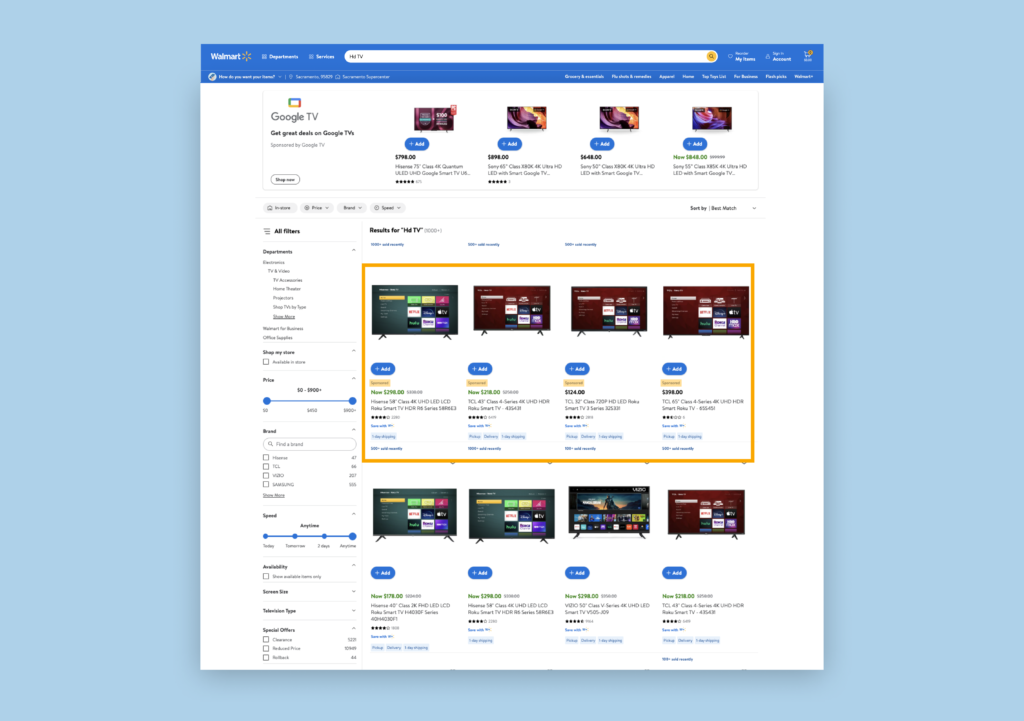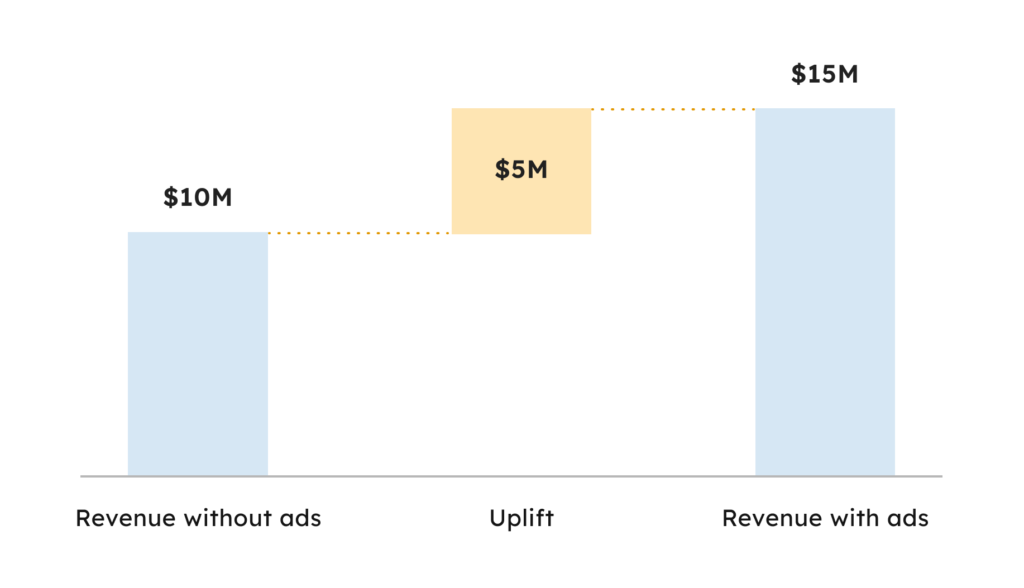With Forrester recently predicting that retail media revenue will balloon to $50 billion globally, it’s clear that the industry’s on a roll. In order to seize opportunities in this latest wave of digital advertising, you need to be fluent in the lingo. That’s why we’ve launched the Ultimate Retail Media Glossary to be your guide. Read on and get started.
Can’t wait? Download our full glossary now.
A
Attribution
The process of evaluating and assigning credit to the marketing touchpoints that a consumer encounters on their path to the desired outcome. Attribution helps marketers understand the impact of their advertising campaigns. See also attribution vs. incrementality.
Audience Targeting
The method of separating consumers into groups based on different criteria, including online behavioral characteristics, demographics, interests, and intent. Marketers use audience targeting to formulate different campaigns that will align directly with their consumers’ lifestyles.
Average Order Value (AOV)
The average amount spent by consumers in each transaction.
AOV = gross revenue / number of orders
B
Bid Price Optimization
Adjusting the price paid for an ad on a retailer’s website to maximize clicks or impressions.
Brand Affinity
The emotional connection between a brand and its customers. People who share the values of a brand tend to choose its product and recommend it to friends.
C
California Consumer Privacy Act (CCPA)
A state statute passed by the California State Legislature in 2018 to enhance privacy rights and consumer protection for residents of California, U.S. It gives consumers more control over the personal information that businesses collect about them.
Catalog Feed
The product inventory of an advertiser which will typically include a product’s ID, name, description, category, image URL, and the product’s URL on the brand’s website.
Click Through Rate (CTR)
A ratio of the number of times an ad is clicked to the number of times an ad is viewed. Typically used as a metric to measure how well an ad is performing.
CTR = Clicks / Impressions
Commerce Data
Attributes of consumer data that enable marketers to understand a customer’s purchase and intent behaviors.
Commerce Intent
People likely to purchase a given product or service. See also in-market audience.
Commerce Media
A subset of digital advertising that uses a customer’s transaction and behavioral data to drive sales. Retail media is a form of commerce media.
Consumer Behavior
The study of how, when, what, and why people buy products and services. Understanding consumer behavior helps marketers efficiently target and implement advertising campaigns.
Consumer Journey or Customer Journey
It is the path taken by a customer via marketing touchpoints before making a purchase decision.

Cookie
A small text file created by a website to recognize and track a user’s preferences. Two major, widely-used types of cookies are first party and third party cookies.
Co-Operative Marketing or “Co-Op” Marketing
An agreement between companies to sell and/or promote each other’s product or service on their platform. Typically referred to as a “co-op.”
Cost of Sales (COS)
The total cost of a campaign divided by the sales that the campaign generated. Or, ad cost as a percentage of revenue.
COS = ad spend/ revenue driven
Customer Lifetime Value (CLV)
CLV is the total amount of money a customer is expected to spend on a company’s products and services during the lifetime of their relationship with the business. It is generally calculated using the following formula:
CLV = average purchase value per order * average number of purchases per year * average customer lifespan
See also Crealytic’s CLV platform.
Customer Targeting
The act of reaching out to a portion of your customer list to re-engage them and drive sales.
D
Data Activation
The process of unlocking value from raw data which involves transforming data into insights and turning insights into action.

Demand Side Platform (DSP)
A programmatic ad platform that allows buyers and marketers to automatically purchase ad inventory from a wide range of publishers or retailers.
See also supply side platform.
Digital Shelf
The space in an online environment where a product is showcased, usually on eCommerce websites or apps. It is the online equivalent of a physical shelf in a brick-and-mortar store.
E
eCommerce
Ecommerce is a business model that allows consumers to buy and sell products and services online.
eCommerce Platform
Software that enables buying and selling over the internet, allowing sellers to manage virtual assets, digital sales, and marketing in one central platform. Shopify and WooCommerce are two well-known eCommerce platforms.
F
First Party Cookie (1P Cookie)
A form of cookie, a small text file created by the website the user is currently viewing which collects first party data directly from the user. Advertising on retailer websites is a key way brands can harness a significant amount of first party, user data to prepare for the ban of third party cookies (definition below).
First Party Data (1P Data)
Information collected by a retailer or other company directly from its users through its owned platforms such as its website or app.
First Party Media Network (1PMN)
An online marketplace allows publishers/marketers to purchase first party data from suppliers/media owners to deliver personalized ads.
Full Funnel Marketing
A marketing strategy that involves reaching a consumer at each stage of the marketing funnel (awareness, consideration, and purchase) with appropriate messages. Sophisticated retail media networks can help equip advertisers (brands) with full-funnel strategies.
G
GDPR (General Data Protection Regulation)
General data protection regulation is an EU law that governs data protection and privacy practices in the European Union. Typically referenced simply as “GDPR” it is among numerous privacy laws enacted to protect consumer data leading to the deprecation of third party coookies.
H
Header Bidding
Also known as advance bidding or pre-bidding, it is an advanced programmatic advertising technique that publishers or retailers use to offer their ad inventory to multiple ad servers and ad exchanges simultaneously in real-time.
I
In-Market Audience
People likely in the market to purchase a given product or service.
Incrementality
A metric used to measure the effectiveness of an ad. It measures the supplemental revenue, clicks or impressions generated from a marketing/advertising tactic.

Incremental Value
Also known as incremental ROAS, it is the lift in value generated from an ad campaign.
Inventory Management
A process used by media owners to package and monetize ad space in their digital properties.
L
Last Touch Attribution
A type of attribution model that gives 100% of the credit to the last touchpoint the user had before making a purchase.
M
Marketplaces
Ecommerce sites that connect buyers and sellers on one platform. Some of the major marketplaces include Amazon, eBay, Walmart, and Zalando.
mCommerce
The buying and selling of goods and services through mobile devices such as cell phones or tablets.
Monetization
The process of turning an asset into revenue. For media owners, this may be ad space on their digital properties, their data, or converting visitors into customers.
Multi-Touch Attribution (MTA)
A type of attribution model that allocates a certain percentage of the credit of a purchase depending on the value generated through each customer touchpoint.
Multichannel eCommerce
A type of business model that provides a consumer multiple ways to interact and purchase from a business.
O
Omnichannel
A type of multichannel approach that ensures the user has a seamless shopping experience irrespective of the channel used.
For example, Starbucks’ mobile rewards app is an omnichannel experience, as it provides users a seamless experience between digital and physical Starbucks stores. On the app, customers can order ahead of going to the store, pay, collect, and track rewards.

Omnichannel Retail
Retail experience that allows a consumer to have a seamless experience whether they are shopping online or in a physical store.
Onsite Search
Optimizing elements on a web page or retailer site to drive more web traffic and improve rankings on a search engine.
Open Internet
Also called open web, open internet refers to digital advertising across the internet, excluding walled gardens.
Opt-out
A user’s preference to no longer receive product or service information. For instance, a user may opt-out of email campaigns or behaviorally targeted ads.
P
Paid Media
Is a type of external marketing effort where an organization promotes its content on a media channel or a publisher’s site, through the purchase of ad inventory.
Post Click Sales
The purchases made by a user within a certain period of time, typically no more than 30 days, after clicking on an ad.
Predictive Bidding
Also called smart bidding, this automated process forecasts each shopper’s engagement (impressions or clicks), conversion, and average order value, and bids the appropriate price for each ad inventory, or buy media, to reach them.
See also smart bidding.
Premium Ad Inventory
Ad inventory that leads to more engagement and conversion thereby attracting higher bids from marketers, or brands in the case of retail media.
Private Marketplace (PMP)
An invite-only marketplace, ad inventory is sold to a select group of buyers.
See also marketplace.
Product Feed Management
The process of administering and optimizing your product feeds in order to optimize the results of your online advertising efforts.
See also product listing optimization.
Product Listing Optimization
Optimizing and enriching elements of a product listing and/or product feed to rank higher in a marketplace or increase traffic and conversions.
Product Recommendations
AI algorithm to improve the match of digital content for specific products based on a shopper’s onsite behavior, such as navigation and the types of products browsed.
Programmatic Advertising
An automated technology that facilitates the process of buying and selling ads in real-time.
Programmatic Mediation
A technology platform that allows buying and selling of ad inventory to multiple demand sources at the same time
Pseudonymous Identifier
An identifier used by an organization that is distinct from a user identity but can be re-identified as needed
Publisher
A media owner that sells or monetizes their ad inventory. In retail media, retailers play the same role as publishers in that they sell ads to brands.
Publisher Monetization
The process of generating revenue by selling owned ad inventory.
R
Real-Time Bidding (RTB)
Buying and selling of ad inventory in an instantaneous programmatic auction through an ad exchange.
Retail Media
A form of digital advertising that involves buying and selling of retailer owned ad inventory usually on retailer websites and apps.
Currently, a growing industry, Forrester predicts retail media ad sales in the U.S. alone will reach approximately $40 billion in 2022 and $85 billion by 2026.
For more, see Crealytics retail media solution.
Retail Media Network (RMN)
An RMN is when retailers set up an advertising business on their website which allows marketers, typically of brands, to buy advertising space and access first party consumer data. It is a method of site monetization for the retailer. See also, How to Scale Your Retail Media Network.
Return on Ad Spend (ROAS)
ROAS is a metric used to measure the efficacy of an ad campaign — the ratio of revenue earned for every dollar of ad spend.
S
Self-Service Platform
Platform with a frontend UI that allows marketers to configure and run campaigns while media owners set paraments on their inventory and check yield.
SKU (Stock Keeping Unit)
A stock keeping unit (always referred to as “SKU”) is a unique code – unit of measure used to manage product inventory.
Smart Bidding
Also known as auction time bidding, smart bidding is a form of automated, predictive bidding coined by Google that refers to bid strategies that use machine learning to optimize for conversions or conversion value in every ad auction.
Smart bidding strategies include: target CPA, target ROAS, maximize conversion, and maximize conversion value.
Sponsored Products
Sponsored products are cost-per-click (CPC) ads that promote individual product listings on eCommerce marketplaces. They promote sales and visibility in search results.
Typically, brands will sponsor products or advertise, on retailers’ websites, which is a way for retailers to monetize.
Sponsored Products Listing
Product listings that are usually promoted to the top of a page and tagged with a “sponsored” label. They generally appear in search results, browsing results, the homepage, product pages, and emails.

Static Ad
Ads, often banners, in which content is pre-prepared, unlike dynamic ads.
Supply Side Platform (SSP)
Also called a sell-side platform, is an AdTech platform used by media owners to manage, sell, and optimize their ad inventory.
See also demand side platform.
T
Third Party Cookie (3P Cookie)
A type of cookie created by a website different from the one the user is currently viewing. These cookies are the basis for third party data. Historically, third party cookies have been used in advertising practices, such as retargeting.
Google will begin phasing out third party cookies in Chrome in the second half of 2024, a move which has prompted many brands to better leverage first party data.

Third Party Data (3P Data)
Data of a user collected by an entity that does not have a direct relationship with the user. Third party data is usually of low quality (not trustworthy) and is collected through third party cookies.
U
Uplift
Similar to incrementality, uplift refers to the increase in revenue, clicks, or impressions resulting from showing an ad.

User ID
A token attributed to a technical identifier, like a cookie or device ID, and specific to a user or device.
W
Walled Gardens
A closed ad platform where the owner or publisher controls and manages buying, serving, tracking, and reporting of ads within the platform. This is opposite to the open internet, which is comparatively more transparent and less expensive.
Examples of walled gardens include Facebook, Google, and Amazon.
Webrooming
Modern buying behavior in which consumers research product information to qualify their buying decision before deciding to buy the product at a physical store.
Get fluent in your retail media lingo
Download our full glossary which includes performance marketing bonus words.
Grow your retail media business
Crealytics can help. Talk to our team to leverage our expertise working with some of the largest eCommerce brands.





